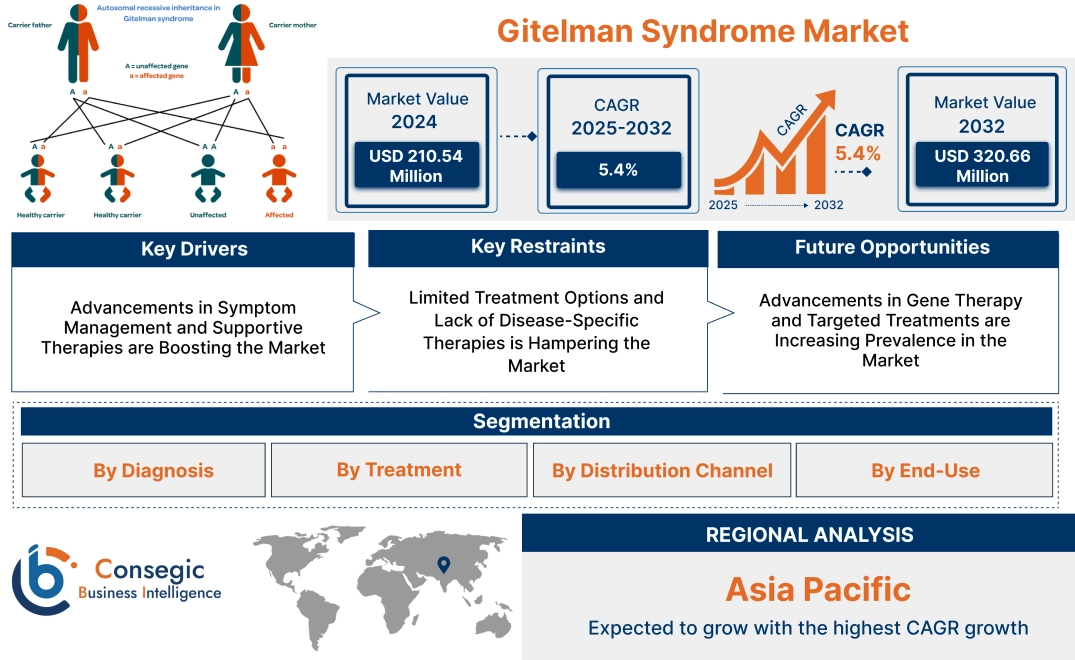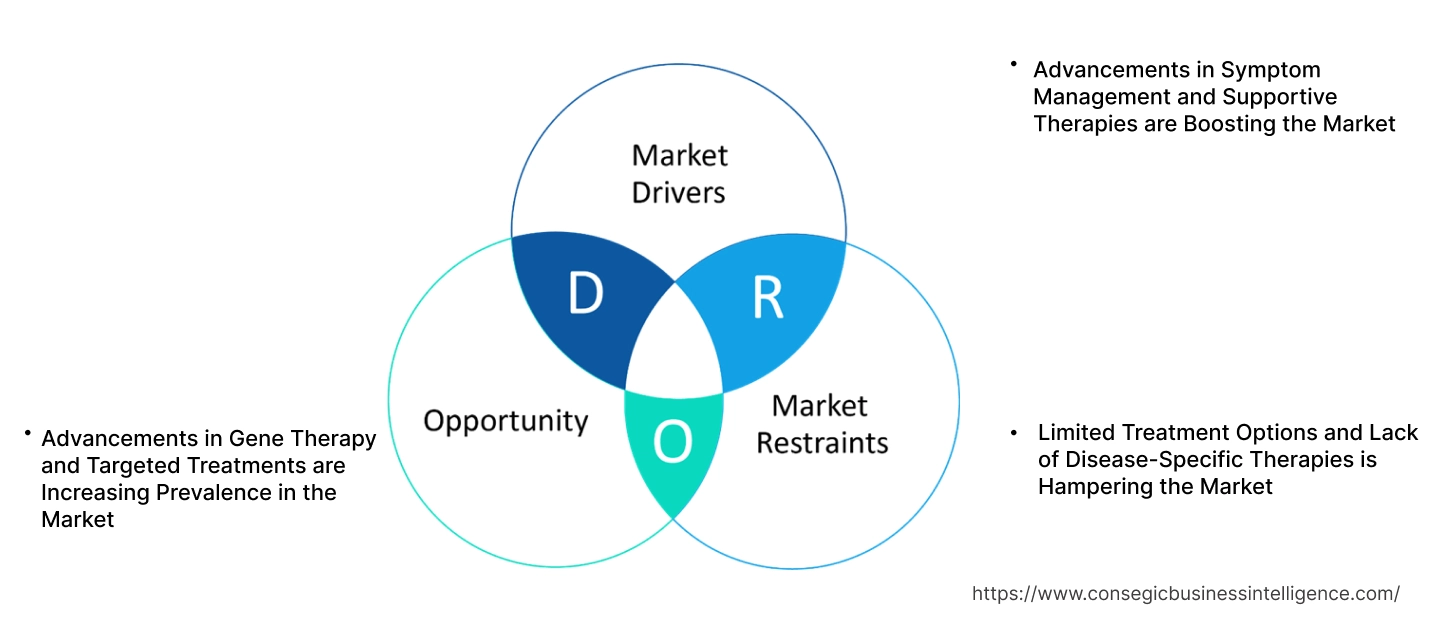Gitelman Syndrome Market Size:
Gitelman Syndrome Market size is estimated to reach over USD 320.66 Million by 2032 from a value of USD 210.54 Million in 2024 and is projected to grow by USD 218.16 Million in 2025, growing at a CAGR of 5.4% from 2025 to 2032.
Gitelman Syndrome Market Scope & Overview:
Gitelman syndrome is a rare genetic disorder characterized by impaired reabsorption of electrolytes in the kidneys, leading to low levels of potassium, magnesium, and calcium in the blood. This condition results in symptoms such as muscle weakness, fatigue, cramps, and, in severe cases, arrhythmias. It is caused by mutations in the SLC12A3 gene and is typically diagnosed through genetic testing and laboratory evaluations of electrolyte levels. Treatment focuses on symptom management through electrolyte supplementation and dietary modifications to maintain mineral balance.
The increasing awareness of rare genetic disorders and advancements in diagnostic tools are driving the trends of the global Gitelman syndrome market. Improvements in genetic testing technologies have enabled earlier and more accurate diagnosis, facilitating better patient management. Additionally, ongoing research into targeted therapies and personalized medicine is expected to further enhance treatment options for this condition.
Key end-users in the Gitelman syndrome market include hospitals, specialty clinics, and research institutions. These entities play a critical role in diagnosing and managing the condition, as well as contributing to the development of innovative therapeutic approaches. The market is poised for steady growth, supported by increased awareness, technological advancements, and a focus on improving patient outcomes.
Key Drivers:
Advancements in Symptom Management and Supportive Therapies are Boosting the Market
Symptom management remains a cornerstone of treatment for Gitelman syndrome, focusing on alleviating complications such as hypokalemia, hypomagnesemia, and muscle weakness. Recent advancements in supportive therapies, including innovative electrolyte replacement formulations and tailored nutritional strategies, are improving patient outcomes. These approaches provide better control over symptoms, enhancing the quality of life for individuals living with this rare genetic disorder.
Trends in personalized medicine have further refined the management of Gitelman syndrome, with targeted approaches addressing individual patient needs. The analysis highlights that continued research into optimizing supportive care is critical for improving long-term outcomes while awaiting the development of curative treatments.
Key Restraints:
Limited Treatment Options and Lack of Disease-Specific Therapies is Hampering the Market
Despite progress in managing symptoms, Gitelman syndrome lacks disease-specific therapies that address its underlying genetic causes. Current treatments focus on mitigating symptoms rather than curing or halting the progression of the disorder. This limitation poses challenges for both patients and healthcare providers, as reliance on symptomatic care may not fully address all complications or prevent potential long-term health issues.
Trends in rare disease research underscore the importance of developing therapies that target the genetic and molecular pathways of Gitelman syndrome. However, the high costs and complexity of research into ultra-rare diseases remain significant barriers to advancing therapeutic options.
Future Opportunities :
Advancements in Gene Therapy and Targeted Treatments are Increasing Prevalence in the Market
The emergence of gene therapy presents a transformative opportunity for addressing the root causes of Gitelman syndrome. By targeting the specific genetic mutations responsible for the condition, gene-based therapies have the potential to provide long-term or even curative solutions. Advances in precision medicine and molecular biology are driving research efforts to develop targeted treatments that go beyond symptomatic relief.
Trends in rare disease therapeutics and growing investments in genetic research are paving the way for novel therapies that could revolutionize care for patients with Gitelman syndrome. Analysis suggests that collaboration between pharmaceutical companies and research institutions will be instrumental in bringing these innovations to market, addressing unmet needs, and improving patient outcomes.
Gitelman Syndrome Market Segmental Analysis :
By Diagnosis:
Based on diagnosis, the market is segmented into genetic testing, blood tests, urine tests, and others.
The genetic testing segment accounted for the largest revenue Gitelman syndrome market share in 2024.
- Genetic testing is considered the gold standard for diagnosing Gitelman syndrome, as it identifies mutations in the SLC12A3 gene associated with the disorder.
- The increasing availability of advanced genetic screening tools has improved early diagnosis and precision in detecting the syndrome.
- Rising awareness about genetic disorders and advancements in next-generation sequencing (NGS) technologies are driving Gitelman syndrome market trends in this segment.
- Collaboration between research institutes and diagnostic laboratories to develop cost-effective genetic tests is further supporting its dominance.
The urine tests segment is anticipated to register the fastest CAGR during the forecast period.
- Urine tests are widely used as an initial diagnostic tool to identify electrolyte imbalances, such as hypokalemia and hypomagnesemia, indicative of Gitelman syndrome.
- The simplicity, affordability, and widespread availability of urine tests make them a preferred choice for primary diagnostics.
- Increasing healthcare access in emerging economies and growing awareness about electrolyte disorders are boosting the adoption of urine testing.
- Technological advancements in laboratory diagnostics, including automated urinalysis systems, are expected to further propel Gitelman syndrome market trends in this segment.
By Treatment:
Based on treatment, the market is segmented into potassium supplements, magnesium supplements, nonsteroidal anti-inflammatory drugs (NSAIDs), thiazide diuretics, and others.
The potassium supplements segment accounted for the largest revenue share in 2024.
- Potassium supplements are the cornerstone of Gitelman syndrome management, addressing the chronic hypokalemia associated with the disorder.
- The increasing prevalence of Gitelman syndrome and rising awareness about the importance of potassium replacement therapy are driving trends.
- Advancements in supplement formulations, including sustained-release options, have improved patient compliance and therapeutic outcomes.
- Growing healthcare infrastructure and the availability of potassium supplements through multiple distribution channels are supporting this segment's dominance.
The magnesium supplements segment is anticipated to register the fastest CAGR during the forecast period.
- Magnesium supplements are crucial for managing hypomagnesemia, a hallmark of Gitelman syndrome, and are often used alongside potassium supplements.
- Rising awareness about the benefits of magnesium supplementation in managing electrolyte imbalances is driving Gitelman syndrome market demand.
- The development of high-bioavailability formulations, such as magnesium glycinate and magnesium citrate, is enhancing patient outcomes.
- The increasing prevalence of electrolyte disorders and advancements in supplement delivery systems are expected to boost segment trends.
By Distribution Channel:
Based on distribution channels, the market is segmented into hospital pharmacies, retail pharmacies, and online pharmacies.
The hospital pharmacies segment accounted for the largest revenue in the Gitelman syndrome market share of 49.60% in 2024.
- Hospital pharmacies are the primary source for prescription-based treatments, including potassium and magnesium supplements, as well as NSAIDs.
- The availability of specialized care and diagnostic services in hospitals supports the dispensing of targeted therapies for Gitelman syndrome.
- The increasing number of hospital admissions for electrolyte imbalances and related complications has bolstered demand for hospital pharmacy services.
- Collaboration between hospitals and pharmaceutical manufacturers to ensure a consistent supply of medications is driving segment Gitelman syndrome market opportunities.
The online pharmacies segment is anticipated to register the fastest CAGR during the forecast period.
- Online pharmacies are gaining popularity due to their convenience, competitive pricing, and home delivery services.
- The increasing adoption of e-commerce platforms for purchasing chronic care medications, including supplements, is driving trends in this segment.
- Rising digital literacy and regulatory support for online pharmacies have enhanced accessibility to treatments for Gitelman syndrome.
- The COVID-19 pandemic accelerated the shift toward online pharmacy usage, a trend that continues to gain momentum.
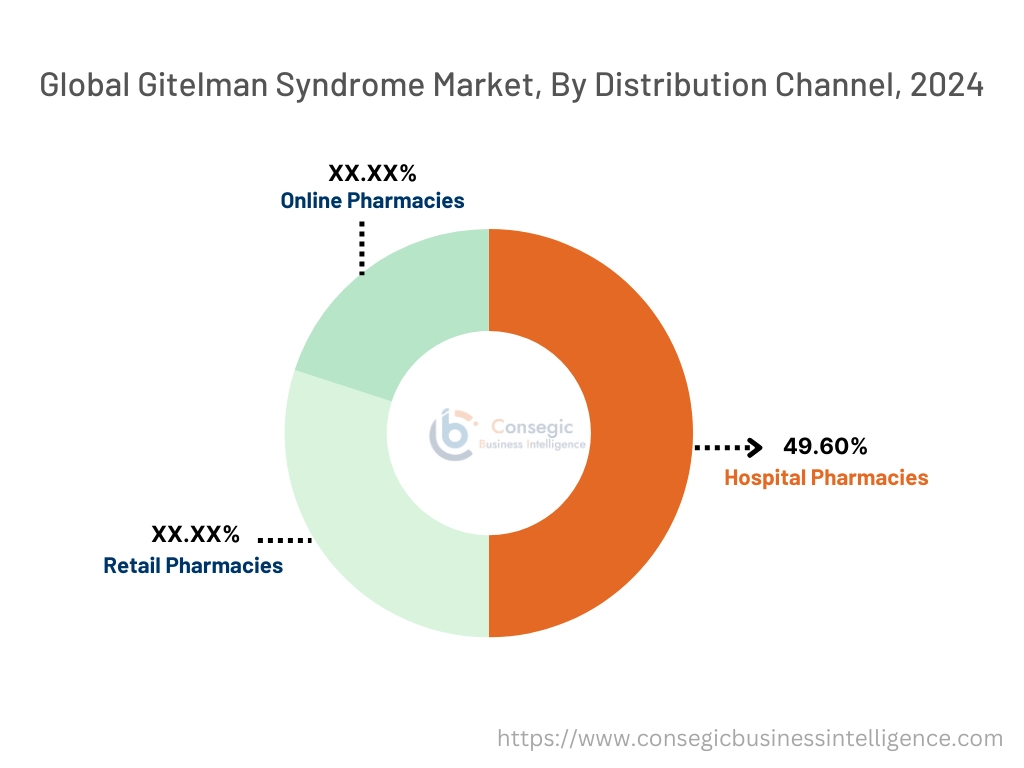
By End-Use:
Based on end-use, the market is segmented into hospitals, specialty clinics, diagnostic laboratories, and research institutes.
The hospitals segment accounted for the largest revenue share in 2024.
- Hospitals are the primary treatment centers for Gitelman syndrome, offering advanced diagnostic and therapeutic options for managing electrolyte imbalances.
- The availability of multidisciplinary teams, including nephrologists and clinical biochemists, enhances patient outcomes in hospital settings.
- Rising hospital admissions for severe cases of hypokalemia and hypomagnesemia have driven demand for hospital-based care.
- Investments in hospital infrastructure and the adoption of advanced diagnostic tools are supporting Gitelman syndrome market growth in this segment.
The diagnostic laboratories segment is anticipated to register the fastest CAGR during the forecast period.
- Diagnostic laboratories play a critical role in the early detection of Gitelman syndrome through genetic, blood, and urine testing.
- The increasing adoption of advanced diagnostic technologies, such as PCR-based tests and next-generation sequencing, is driving trends.
- Rising collaborations between diagnostic laboratories and research institutes are enhancing the development of cost-effective testing solutions.
- Growing healthcare access and the expansion of laboratory networks in emerging economies are expected to boost this segment’s growth.
Regional Analysis:
The regions covered are North America, Europe, Asia Pacific, the Middle East and Africa, and Latin America.
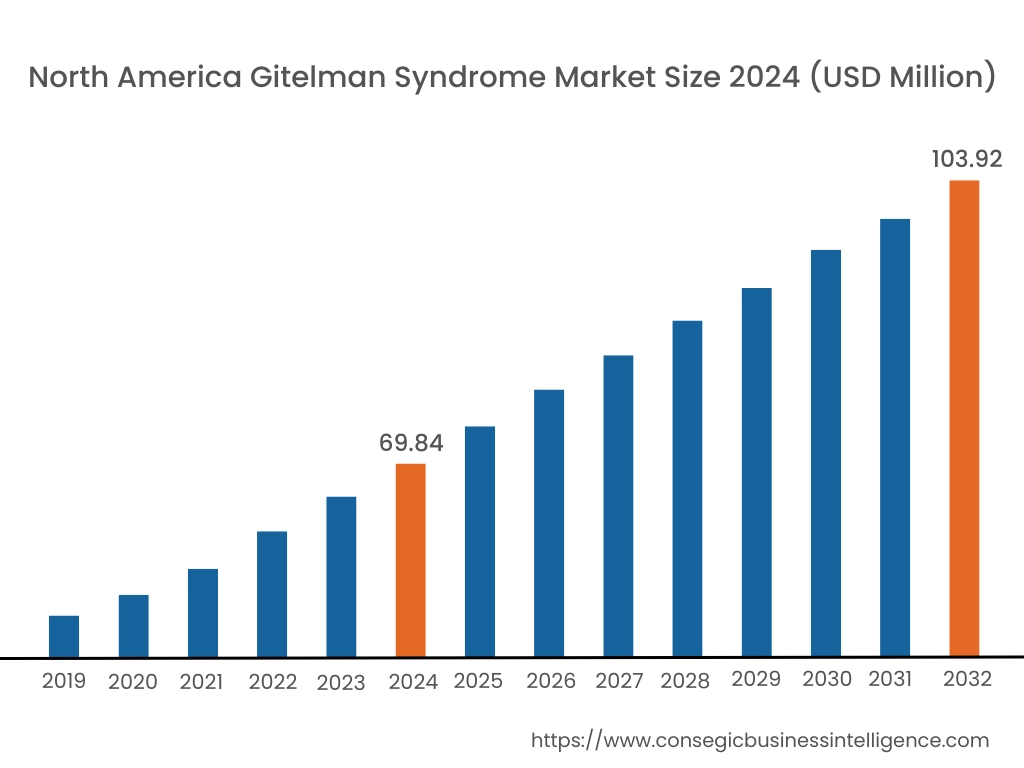
In 2024, North America was valued at USD 69.84 Million and is expected to reach USD 103.92 Million in 2032. In North America, the U.S. accounted for the highest share of 71.60% during the base year of 2024. North America holds a significant share of the global Gitelman Syndrome market, driven by a well-established healthcare infrastructure and growing awareness about rare genetic disorders. The U.S. leads the region, with increasing diagnosis rates due to advanced genetic testing capabilities and growing research on orphan diseases. The presence of specialized healthcare facilities and patient advocacy groups further supports the treatment and management of Gitelman Syndrome. As per the Gitelman syndrome market analysis Canada contributes through its expanding focus on rare diseases and collaborative research initiatives. However, the high cost of genetic testing and limited treatment options may restrict access for some patients.
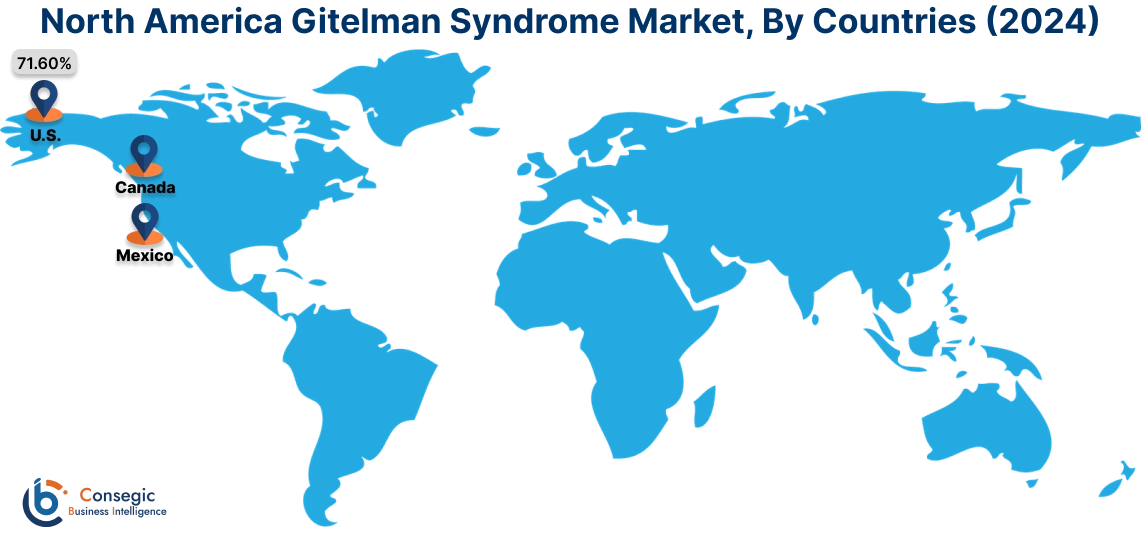
In Asia Pacific, the market is experiencing the fastest growth with a CAGR of 5.8% over the forecast period. The Gitelman Syndrome market is fueled by increasing healthcare investments, growing awareness about genetic diseases, and advancements in diagnostic technologies in China, India, and Japan. China leads the region with the rising adoption of genetic testing and research into rare genetic disorders. India’s expanding healthcare infrastructure and government initiatives for rare diseases drive demand for better diagnostic and treatment options. Japan emphasizes advanced genetic research and the development of innovative therapies for rare conditions like Gitelman Syndrome. However, limited awareness in rural areas and affordability challenges may restrict access to diagnosis and care in some parts of the region.
Europe is a prominent market, supported by robust healthcare systems and rising awareness about genetic disorders. Countries like Germany, France, and the UK are key contributors. Germany drives demand with its advanced diagnostic capabilities and growing investment in rare disease research. France emphasizes government support and patient-centered care for managing rare diseases like Gitelman Syndrome. The UK focuses on genetic counseling and treatment innovations, leveraging its strong academic research base. However, challenges such as delayed diagnosis and the high cost of treatment may hinder market growth in some parts of the region.
The Middle East & Africa region is witnessing a steady rise in Gitelman syndrome market growth, driven by increasing healthcare investments and efforts to improve rare disease diagnosis. In the Middle East, countries like Saudi Arabia and the UAE are adopting advanced genetic testing technologies in hospitals and specialized clinics to identify and manage rare disorders. As the Gitelman syndrome market analysis depicts Africa, South Africa is emerging as a market, focusing on raising awareness and improving access to healthcare for rare diseases. However, limited infrastructure and reliance on imports for advanced diagnostics may hinder market development in some parts of the region.
Latin America is an emerging market, with Brazil and Mexico leading the region. Brazil’s growing focus on rare disease management and expanding healthcare infrastructure drive Gitelman syndrome market demand for genetic testing and specialized care. Mexico emphasizes improving access to diagnostics and treatment for rare conditions, supported by government healthcare initiatives. The region’s analysis depicts the increasing participation in international collaborations for rare disease research further supports market growth. However, economic instability and inconsistent healthcare policies may pose challenges to market development in smaller economies.
Top Key Players and Market Share Insights:
The Gitelman syndrome market is highly competitive with major players providing products to the national and international markets. Key players are adopting several strategies in research and development (R&D), product innovation, and end-user launches to hold a strong position in the Gitelman syndrome market. Key players in the Gitelman syndrome industry include -
- GlaxoSmithKline plc (United Kingdom)
- Pfizer Inc. (United States)
- Lupin Limited (India)
- Sun Pharmaceutical Industries Ltd. (India)
- Hoffmann-La Roche AG (Switzerland)
- Novartis AG (Switzerland)
- Sanofi S.A. (France)
- Eli Lilly and Company (United States)
- Teva Pharmaceutical Industries Ltd. (Israel)
- Cipla Ltd. (India)
Gitelman Syndrome Market Report Insights :
| Report Attributes | Report Details |
| Study Timeline | 2019-2032 |
| Market Size in 2032 | USD 320.66 Million |
| CAGR (2025-2032) | 5.4% |
| By Diagnosis |
|
| By Treatment |
|
| By Distribution Channel |
|
| By End-Use |
|
| By Region |
|
| Key Players |
|
| North America | U.S. Canada Mexico |
| Europe | U.K. Germany France Spain Italy Russia Benelux Rest of Europe |
| APAC | China South Korea Japan India Australia ASEAN Rest of Asia-Pacific |
| Middle East and Africa | GCC Turkey South Africa Rest of MEA |
| LATAM | Brazil Argentina Chile Rest of LATAM |
| Report Coverage |
|
Key Questions Answered in the Report
What is the estimated size of the Gitelman Syndrome Market by 2032? +
Gitelman Syndrome Market size is estimated to reach over USD 320.66 Million by 2032 from a value of USD 210.54 Million in 2024 and is projected to grow by USD 218.16 Million in 2025, growing at a CAGR of 5.4% from 2025 to 2032.
What are the primary drivers of the Gitelman Syndrome Market? +
The market is driven by advancements in genetic testing, increasing awareness of rare genetic disorders, and improvements in supportive therapies for managing symptoms like hypokalemia and hypomagnesemia.
What challenges are hindering the growth of the Gitelman Syndrome Market? +
Limited treatment options that address the root cause of the disease and high costs associated with genetic testing and rare disease research are major challenges in the market.
What opportunities exist in the Gitelman Syndrome Market? +
The development of gene therapies and targeted treatments represents a significant opportunity to address the underlying genetic causes of Gitelman Syndrome, potentially providing curative solutions.
Which diagnostic method dominates the market? +
Genetic testing holds the largest market share due to its ability to accurately identify mutations in the SLC12A3 gene, which is critical for confirming a diagnosis of Gitelman Syndrome.
